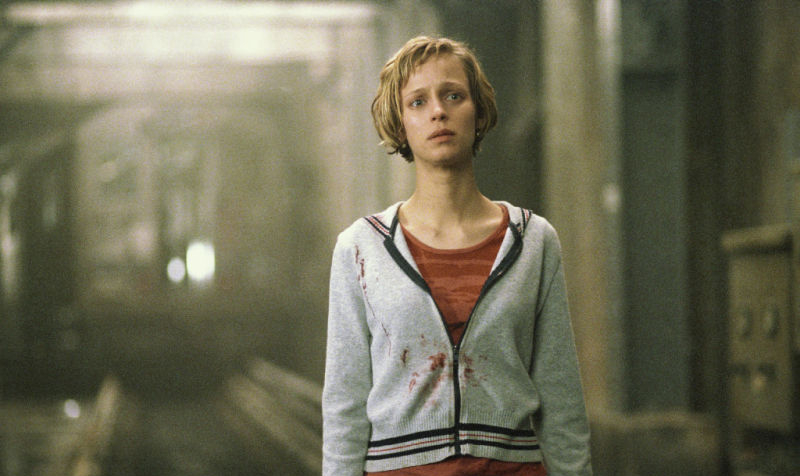They (2002)—Nightmares, Insanity and Disappointment

Raise your hand if you’ve experienced night terrors as a child. Wow, that’s a lot of hands. Ok, you can put your hands down. Since we’re on this subject, remember Wes Craven? The creator of A Nightmare on Elm Street, one of the most iconic franchises in slasher film history? Well, I found out that he was both an executive producer and presenter of a small horror movie in 2002 aptly named They. And funnily enough, this movie also addressed the subject of childhood nightmares while not featuring a burned man wielding a butter knife glove.
Julia Lund (played by Laura Regan) is doing her Master’s Degree in psychology who suffered from severe night terrors as a child. One night, she meets up with her childhood friend Billy who also suffered from night terrors. Billy claims he was being followed “them”, but doesn’t specify who they are. He shoots himself when he notices the lights flickering, shocking Julia. At Billy’s funeral, Julia meets two of his friends: Sam and Terry. While sorting through his belongings, she finds his journal containing entries claiming that creatures were after him. Despite initially thinking he was under the influence, both later claim to be suffering from night terrors and find strange marks on their bodies similar to Billy’s. When both Terry and Sam go missing, Julia begins suspecting that “they” are behind their disappearance.

I’ll start off by saying that this is the first Wes Craven production I’ve seen that doesn’t belong to either the Nightmare on Elm Street or Scream franchise. And while the subject matter may mirror the former, it does take a rather unique spin. Much like A Nightmare on Elm Street, Wes Craven’s They relies on psychological horror to keep audiences on their toes. The film creates this dreamlike and surrealistic atmosphere that gaslights viewers into questioning their own reality and the reality of the characters. This is on full display whenever Julia or the others encounter the creatures (“them”). Since only characters who are marked can see and touch them, you don’t know if they are hallucinating or if they’re actually being attacked. This mystery fills you with a looming sense of dread as your heartbeat quickens whenever you gaze upon the darkness behind a closet door or catch the glimpse of the slightest flicker of lights as you fear for their safety or sanity.
Even though the creatures’ only weakness is light, they still have the ability to short out many existing sources of light. We are so used to seeing movie monsters take a serious hit or be destroyed after a measly exposure to their weakness. However in They, the creatures only disappear after being exposed to a new source of light. This makes them so much more dangerous since you can’t hope to fight them, only run away whenever they appear. Initially, the creatures were imagined as bio-organic machines that reused spare human parts. Would this have made them more terrifying? Well, I for one would have loved to see their design if given a bigger budget. But with the budget the film got, it wouldn’t have achieved nearly the potential I (and many others) would’ve imagined. And while they do appear rather monstrous in the finished film, I do think they looked a bit too generic. Freddy Krueger had an iconic look with his burned skin, Christmas sweater and finger knife glove. But these creatures? You could put them in almost any creature horror movie and they‘d fit right in.

I firmly believe horror as a genre doesn’t get the respect it deserves. Most people see horror films as just tasteless scares and shocking gore. But I don’t think that’s the case. Horror is one of the most flexible film genres to exist. As a medium, it can be used to explore the darkest sides of humanity and social taboos of our time. And upon conducting a deeper analysis of Wes Craven’s They, I think the creatures represent repressed childhood trauma stemming from abuse. This explains the mark imprinted onto their victims resembling a small, but dark cut or bruise. However, unlike Freddy Krueger, the creatures don’t have any personality to bounce off the human characters (not that the humans really had much personality to begin with). They’re just mindless monsters who appear and drag their victims off screen. A Nightmare on Elm Street used Freddy as a metaphor for childhood sexual assault which carries on as trauma affecting the teens later on. He quips with his victims before killing them to add salt in the wound. But the creatures in They are just random monsters. They have no names or even the ability to speak. They appear, stalk and drag someone off screen and then disappear like the rain. Do we care? I don’t know.
Wes Craven’s They was made on a budget of $17 million and only made back a little over $16 million, making it a box office bomb. But maybe it was a critical success right? Well…no. It got a rather negative reception from critics at the time and the film was mostly forgotten. This is a shame, since I actually thought it was a unique approach to the trauma children and adults face induced by night terrors. However, the execution didn’t quite live up to the vision. The creatures themselves were generic looking and the side characters were all forgettable. If you are interested in checking the movie out, it’s available on both Max and Hulu. And if you so happen to find a mysterious bruise on your body the next morning that wasn’t there the night before, well…it’s been nice knowing you.









